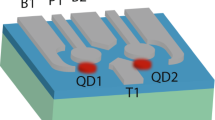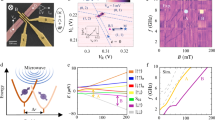Abstract
Future communication and computation technologies that exploit quantum information require robust and well-isolated qubits. Electron spins in III–V semiconductor quantum dots, although promising candidate qubits, see their dynamics limited by undesirable hysteresis and decohering effects of the nuclear spin bath. Replacing electrons with valence-band holes should suppress the hyperfine interaction and consequently eliminate strong nuclear effects. Such suppression was recently observed in optical initialization and coherent population trapping experiments, but complete control over the phase of an arbitrary hole superposition—the essence of a hole-based qubit—has not yet been achieved. Using picosecond optical pulses, we now demonstrate complete coherent control of a single hole qubit and examine both free-induction and spin-echo decay. In moving from electrons to holes, we observe the effects of the reduced hyperfine interactions in the re-emergence of hysteresis-free dynamics, while obtaining similar coherence times limited by non-nuclear mechanisms. These results demonstrate the potential of optically controlled quantum-dot hole qubits.
This is a preview of subscription content, access via your institution
Access options
Subscribe to this journal
Receive 12 print issues and online access
$209.00 per year
only $17.42 per issue
Buy this article
- Purchase on Springer Link
- Instant access to full article PDF
Prices may be subject to local taxes which are calculated during checkout




Similar content being viewed by others
References
Ladd, T. D. et al. Quantum computers. Nature 464, 45–53 (2010).
Coish, W. A. & Loss, D. Hyperfine interaction in a quantum dot: Non-Markovian electron spin dynamics. Phys. Rev. B 70, 195340 (2004).
Petta, J. R. et al. Coherent manipulation of coupled electron spins in semiconductor quantum dots. Science 309, 2180–2184 (2005).
Yao, W., Liu, R-B. & Sham, L. J. Theory of electron spin decoherence by interacting nuclear spins in a quantum dot. Phys. Rev. B 74, 195301 (2006).
Witzel, W. M. & Das Sarma, S. Quantum theory for electron spin decoherence induced by nuclear spin dynamics in semiconductor quantum computer architectures: Spectral diffusion of localized electron spins in the nuclear solid-state environment. Phys. Rev. B 74, 035322 (2006).
Press, D. et al. Ultrafast optical spin echo in a single quantum dot. Nature Photon. 4, 367–370 (2010).
Viola, L. & Lloyd, S. Dynamical suppression of decoherence in two-state quantum systems. Phys. Rev. A 58, 2733–2744 (1998).
Biercuk, M. et al. Optimized dynamical decoupling in a model quantum memory. Nature 458, 996–1000 (2009).
Du, J. et al. Preserving electron spin coherence in solids by optimal dynamical decoupling. Nature 461, 1265–1268 (2009).
de Lange, G., Wang, Z. H., Ristè, D., Dobrovitski, V. V. & Hanson, R. Universal dynamical decoupling of a single solid-state spin from a spin bath. Science 330, 60–63 (2010).
Bluhm, H. et al. Dephasing time of GaAs electron-spin qubits coupled to a nuclear bath exceeding 200 μs. Nature Phys. 7, 109–113 (2011).
Vink, I. T. et al. Locking electron spins into magnetic resonance by electron–nuclear feedback. Nature Phys. 5, 764–768 (2009).
Latta, C. et al. Confluence of resonant laser excitation and bidirectional quantum-dot nuclear-spin polarization. Nature Phys. 5, 758–763 (2009).
Xu, X. et al. Optically controlled locking of the nuclear field via coherent dark-state spectroscopy. Nature 459, 1105–1109 (2009).
Ladd, T. D. et al. Pulsed nuclear pumping and spin diffusion in a single charged quantum dot. Phys. Rev. Lett. 105, 107401 (2010).
Balasubramanian, G. et al. Ultralong spin coherence time in isotopically engineered diamond. Nature Mater. 8, 383–387 (2008).
Kane, B. A silicon-based nuclear spin quantum computer. Nature 393, 133–137 (1998).
Borselli, M. G. et al. Measurement of valley splitting in high-symmetry Si/SiGe quantum dots. Appl. Phys. Lett. 98, 123118 (2011).
De Greve, K. et al. Photon antibunching and magnetospectroscopy of a single fluorine donor in ZnSe. Appl. Phys. Lett. 97, 241913 (2010).
Bulaev, D. V. & Loss, D. Spin decoherence and relaxation of holes in a quantum dot. Phys. Rev. Lett. 95, 076805 (2005).
Fischer, J., Coish, W. A., Bulaev, D. V. & Loss, D. Spin decoherence of a heavy hole coupled to nuclear spins in a quantum dot. Phys. Rev. B 78, 155329 (2008).
Gerardot, B. D. et al. Optical pumping of a single hole spin in a quantum dot. Nature 451, 441–444 (2008).
Brunner, D. et al. A coherent single-hole spin in a semiconductor. Science 325, 70–72 (2009).
Fallahi, P., Yilmaz, S. T. & Imamoglu, A. Measurement of a heavy-hole hyperfine interaction in InGaAs quantum dots using resonance fluorescence. Phys. Rev. Lett. 105, 257402 (2010).
Chekhovich, E. A., Krysa, A. B., Skolnick, M. S. & Tartakovskii, A. I. Direct measurement of the hole-nuclear spin interaction in single quantum dots. Phys. Rev. Lett. 106, 027402 (2010).
Berezovsky, J., Mikkelson, M. H., Stoltz, N. G., Coldren, L. A. & Awschalom, D. D. Picosecond coherent optical manipulation of a single electron spin in a quantum dot. Science 320, 349–352 (2008).
Press, D., Ladd, T. D., Zhang, B. & Yamamoto, Y. Complete quantum control of a single quantum dot spin using ultrafast optical pulses. Nature 456, 218–221 (2008).
Semenov, Y. G., Borysenko, K. N. & Kim, K. W. Spin-phase relaxation of two-dimensional holes localized in a fluctuating potential. Phys. Rev. B 66, 113302 (2002).
Sleiter, D. & Brinkman, W. F. Using holes in GaAs as qubits: An estimate of the Rabi frequency in the presence of an external rf field. Phys. Rev. B 74, 153312 (2006).
Roloff, R., Eissfeller, T., Vogl, P. & Pötz, W. Electric g tensor control and spin echo of a hole-spin qubit in a quantum dot molecule. New J. Phys. 12, 093012 (2010).
Nowack, K. C., Koppens, F. H. L., Nazarov, Y. V. & Vandersypen, L. M. K. Coherent control of a single spin with electric fields. Science 318, 1430–1433 (2007).
Nadj-Perge, S., Frolov, S. M., Bakkers, E. P. A. M. & Kouwenhoven, L. P. Spin–orbit qubit in a semiconductor nanowire. Nature 468, 1084–1087 (2010).
Atatüre, M. et al. Quantum-dot spin-state preparation with near-unity fidelity. Science 312, 551–553 (2006).
Xu, X. et al. Fast spin state initialization in a singly charged InAs–GaAs quantum dot by optical cooling. Phys. Rev. Lett. 99, 097401 (2007).
Economou, S. E., Sham, L. J., Wu, Y. & Steel, D. G. Proposal for optical U(1) rotations of electron spin trapped in a quantum dot. Phys. Rev. B 74, 205415 (2006).
Nielsen, M. A. & Chuang, I. L. Quantum Computation and Quantum Information (Cambridge Univ. Press, 2000).
Eble, B. et al. Hole-nuclear spin interaction in quantum dots. Phys. Rev. Lett. 102, 146601 (2009).
Testelin, C., Bernardot, F., Eble, B. & Chamarro, M. Hole-spin dephasing time associated with hyperfine interaction in quantum dots. Phys. Rev. B 79, 195440 (2009).
Fischer, J. & Loss, D. Hybridization and spin decoherence in heavy-hole quantum dots. Phys. Rev. Lett. 105, 266603 (2010).
Syperek, M. et al. Spin coherence of holes in GaAs/(Al,Ga)As quantum wells. Phys. Rev. Lett. 99, 187401 (2007).
Heiss, D. et al. Observation of extremely slow hole spin relaxation in self-assembled quantum dots. Phys. Rev. B 76, 241306(R) (2007).
Warburton, R. J. et al. Optical emission from a charge-tunable quantum ring. Nature 405, 926–929 (2000).
Acknowledgements
We thank W. Coish for valuable discussions. This work was supported by NICT, NSF CCR-08 29694, NIST 60NANB9D9170, Special Coordination Funds for Promoting Science and Technology, the State of Bavaria, and by the JSPS through its FIRST Program. P.L.M. acknowledges support as a David Cheriton Stanford Graduate Fellow.
Author information
Authors and Affiliations
Contributions
D.B., C.S., M.K. and S.H. grew and fabricated the samples. K.D.G., P.L.M. and D.P. performed the optical experiments. T.D.L. provided theoretical analysis and guidance. Y.Y., L.W., S.H. and A.F. guided the work. K.D.G. wrote the manuscript with input from all authors.
Corresponding author
Ethics declarations
Competing interests
The authors declare no competing financial interests.
Supplementary information
Supplementary Information
Supplementary Information (PDF 731 kb)
Rights and permissions
About this article
Cite this article
De Greve, K., McMahon, P., Press, D. et al. Ultrafast coherent control and suppressed nuclear feedback of a single quantum dot hole qubit. Nature Phys 7, 872–878 (2011). https://doi.org/10.1038/nphys2078
Received:
Accepted:
Published:
Issue Date:
DOI: https://doi.org/10.1038/nphys2078
This article is cited by
-
Ideal refocusing of an optically active spin qubit under strong hyperfine interactions
Nature Nanotechnology (2023)
-
Coherent control of a high-orbital hole in a semiconductor quantum dot
Nature Nanotechnology (2023)
-
Optical charge injection and coherent control of a quantum-dot spin-qubit emitting at telecom wavelengths
Nature Communications (2022)
-
Engineering long spin coherence times of spin–orbit qubits in silicon
Nature Materials (2021)
-
Error-detected N-photon cluster state generation based on the controlled-phase gate using a quantum dot in an optical microcavity
Frontiers of Physics (2020)



